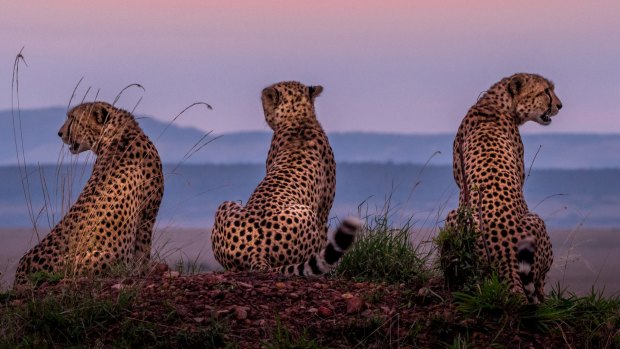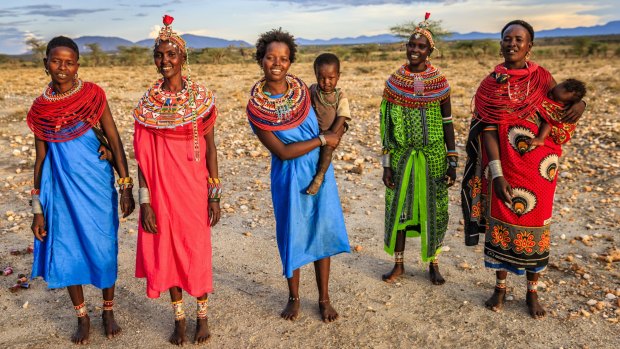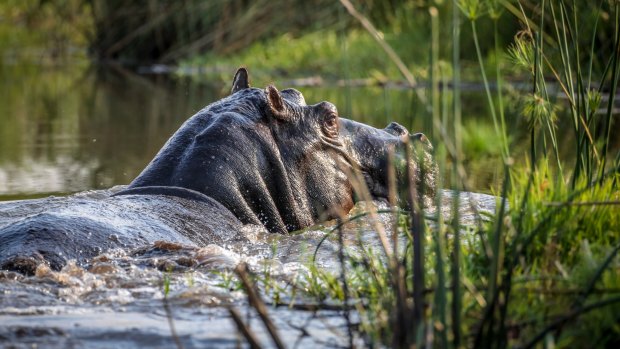This was published 4 years ago
Maasai Mara National Reserve, Kenya tours: Wildlife encounters that are hard to beat
By Keith Austin

Cheetahs are effortlessly cool.Credit: iStock
There is, of course, an expectation of animal sightings. This is Africa, after all, and we're heading out to the Maasai Mara National Reserve in south-western Kenya where lions, cheetahs, elephants, zebras, hippos, various antelope and wildebeest are hanging about in indolent anticipation of being photographed.
But a giraffe sighting on the main road from Nairobi's Jomo Kenyatta International Airport? That is unexpected.
It turns out we're driving past Nairobi National Park, established in 1946 just seven kilometres south of the centre of the Kenyan capital and cheek-by-growl with the airport. The smallest of the country's national parks, it's said to be the only one with a skyscraper backdrop.

The locals wear wear the most vibrant and colourful clothing possible.Credit: iStock
Which rather defeats the object, if you ask me. Call me a cliched old fool, but I want my elephants lumbering past those flat-topped acacia trees, not hanging around outside the local 7-Eleven.
Of course, the next day it's tempting to change one's mind after six teeth-rattling hours hurtling over roads seemingly made of corrugated iron to reach the Maasai Mara reserve and enduring what George Njuguna Mwaura, our guide and chief entertainment officer, laughingly describes as an African massage.
This is a jest, of course; I'd walk barefoot over broken glass and hot coals to get to the Maasai Mara.

No swimming: A hippo wallows in the waters.Credit: iStock
In comparison with the Nairobi National Park's piddly 117 square kilometres, the Maasai Mara consists of 1510 square kilometres of savannah wilderness crossed by the Mara and Talek rivers. These flat plains run all the way to the Tanzanian border, beyond which is the Serengeti. It's across this border that the famous migrations take place each year.
The great tourist migration from Nairobi to the Maasai Mara will be eased when a modern highway opens between the two in a few years but for now expect seemingly endless construction work and that vigorous African "massage".
On the way we stop at a lookout to admire the Great Rift Valley, the series of adjoining trenches which extend 6000 kilometres from the Beqaa Valley in Lebanon to Mozambique in south-eastern Africa, and to take the first of many millions of photographs of the local fauna.
In this case it's something called a hyrax, a family of which are scurrying around below us in the scrubby undergrowth. Imagine a scowling quokka with an obesity problem and you've got it in one. It's not a blood-stained lion ripping apart a recently deceased antelope, but you've got to start somewhere.
The one thing the long ride does do is serve as an introduction to the country, from the traffic-clogged streets of modern, bustling Nairobi to the rural areas where goats and cattle graze the verges accompanied by tall, slim and frighteningly elegant Maasai men and women in the bright colours of their traditional clothing.
We pass ramshackle fruit-and-vegetable stalls patched together out of discarded wood, wire and plastic sheeting, and shanty-style "towns" that look as if a strong wind would blow them away.
And among it all are the people, who seem to have responded to the Ralph Lauren, autumn-collection-colour-scheme of the landscape by putting their collective foot down and deciding they're going to wear the most vibrant and colourful clothing possible.
This is, after all, tropical savannah and apart from the occasional burst of bougainvillea overflowing a garden wall, there's a lot of brown. Or there is until another local wanders into view wearing a dress, shirt or headdress that can surely be seen from space. It's like watching beautifully bright flowers bloom in the desert.
Our home for the next two nights is the Fig Tree Camp, a low-key but lovely lodge which sits on a sharp bend in the Talek River. My safari tent overlooks said river and there is a sign outside that reads "Don't Go Beyond This Point". Given that just below this there is a gigantic crocodile lazing in the shallows and, a little further on, a waterhole filled with wallowing hippos, this seems eminently sensible advice.
After lunch at Fig Tree we return to the LandCruiser and pop the viewing roof for an afternoon/evening game drive that culminates in one of those sunsets that defies belief. Given we've already seen zebra, buffalo, gazelles, lions, a leopard, a family of hyenas, giraffe and baboons, this is almost too much.
There are animals outlined in the distance, a couple of acacia trees and, between them, a setting sun the colour of molten gold dropping into a purple haze horizon and turning the sky crimson-yellow. It's all so cliched and yet all so perfect.
After a buffet dinner which features a high jumping "dance" performance by a posse of Maasai warriors in their cheerful clothes we retire to bed in order to be awake for our pre-dawn balloon ride.
(In the night I am woken by the guttural grunt and splash of a hippopotamus doing its laundry right outside my tent. At least that's what it sounded like – I was too chicken to find out.)
At Oh-My-Good-Grief o'clock we gather in reception and follow our guide to a nearby field where a hot-air balloon is being slowly inflated above a large wicker basket.
We – there are 13 of us in the basket – are soon drifting slowly over the camp and off into the panoramic flat plains of the Maasai Mara. It's cold and quiet as we float higher and higher, the only sounds the roar of the flames as the "captain" opens the propane blast valve, the plaintive click of cameras and the giggle of teenagers taking selfies with groggy dawn in the background.
Later, the captain explains that July and August are the best times to see animals, which would explain the paucity of them on our journey. This sounds like a complaint but it's not; we see elephants, a hippo, ostriches and some wildebeest but they do get a bit lost in the vastness of the landscape, which is to my mind the main attraction up here.
After an hour we land softly and are picked up by 4WDs which take us to breakfast. This is set up on a long communal table on the open grasslands and is pretty much all-you-can-eat washed down with sparkling wine and eye-wincingly strong Bloody Marys. It's all terribly civilised and quite, quite wonderful.
On our way back to the lodge we stop at a watering hole where an elephant and her small offspring are splashing and rolling around in the muddy water. It's quite something to see. Or at least we think so until another group arrives. And then another, and another.
Eventually, there are about 15 elephants of all shapes and sizes loitering around the waterhole, and us. All we need is for Mowgli to turn up to complete The Jungle Book elephant patrol vibe.
The next day we head north to Lake Nakuru National Park (with Amboseli National Park and Kilimanjaro on the itinerary after that) but not before one last game drive.
At first it's hard to imagine that anything can beat yesterday's sightings but in quick succession we encounter several topi, the beautifully coloured antelope with shiny coats and ringed horns, and possibly my favourite African bird, the cartoon-coloured lilac-breasted roller.
Beating these into a cocked hat, though, are the five male cheetahs we come across lazing around looking effortlessly cool. One of them even saunters insouciantly around our vehicle within touching distance before flopping down with his brethren in the shade.
And there are still five days to go.
TRIP NOTES
MORE
Keith Austin travelled as a guest of G Adventures.
FLY
Most major airlines fly to Kenya with one or two stops from Sydney, Melbourne and Brisbane. For details of flights see flightcentre.com.au
THE TOUR
An eight-day Kenya Safari Experience small-group (no more than six people) National Geographic Journeys with G Adventures' tour is priced from $4629 per person and includes accommodation, most meals (allow $US100-$US130 for meals not included), a chief experience officer (CEO) throughout, transportation and most activities. Prices do not include flights. For more information or to book, call 1300 180 969 or visit gadventures.com.au
A visa is needed to visit Kenya and can be obtained online for $US51. Visit kenyaonlinevisas.com for details.
BALLOON RIDE
Adventures Aloft Balloon Safari costs $US450 per person and includes a one-hour flight, return transport to the camp, en-route game drives and a champagne breakfast. Not recommended for children under 10 and people with health and/or back problems as the landing can be bumpy. Book in advance through gadventures.com.au
Sign up for the Traveller Deals newsletter
Get exclusive travel deals delivered straight to your inbox. Sign up now.